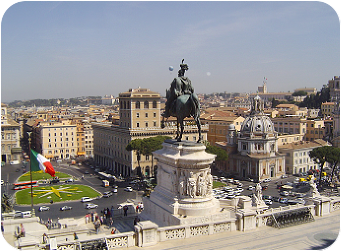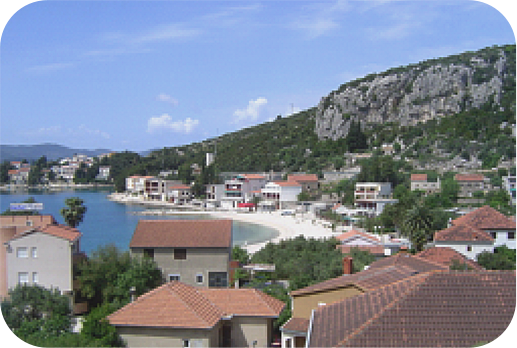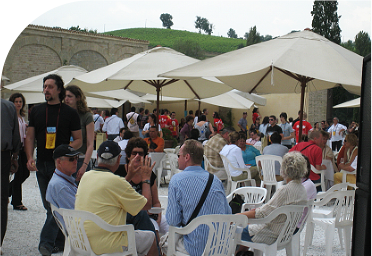Tales of Big Julie and Foraging the Forum There is something about pondering the Forum…
Lack a Lickker in Lucca & Packing a Pisolino in Pisa
Download a PDF Version of this article
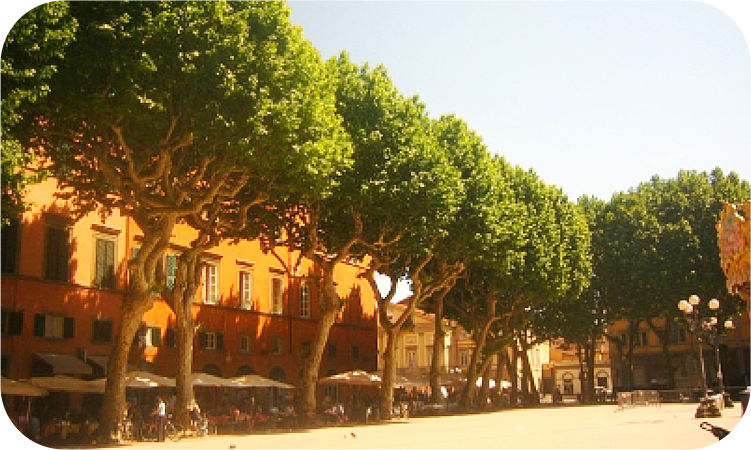
Lucca lends it self to arrival by train and the capacity to travel by Trenitalia can only be truly tested when coming via Firenze (Florence) as this required a new test in ticket trauma. A place as busy as Firenze Stazione can expect some hiccups as the great unwashed chatter amidst the clicking and clattering of the shimmering arrivals and departures board which is constantly changing and charting train movements as the queues build up. The scene is redolent of a Lebanese hospital scene as innate inefficiency prevailed with four lines snaking out into the moving masses thwarting attempts to make passage down the station. No amount of pressure fazed the staff, even if some tickets took ten minutes to activate, and after eighty minutes waiting the shrug on asking was “it is like this everyday”. One wonders what Italian sport is”bigletteri Bingo or ticketing triathlon” as a certain temperament would be required to put up with the continual harassment.
The ticket delay means the only train left is a regionale that takes two and half hours instead of seventy minutes and introduces a new sport of social engagement. A potpourri of suspicious and unsavoury characters had frequent trips to the toilet for purposes of illicit drug taking and seeming loneliness as more than one was required to be in attendance. The law of stazione attrition came into play and the carriage constricted to four players of which the two strangers both English speakers were engaged in friendly banter. The ex Sri Lankan army officer filled in his tale of eight years as an illegal immigrant and how he went in and out of Italy and his companion a Filipina Girl had been there a year without a permit as her prospects were nil in the Philippines. Il Traino after 3 waits at stations for passing traffic and countless stops for disembarkation flushed the remaining passengers onto Lucca platform and the 8.30 pm search for accommodation.
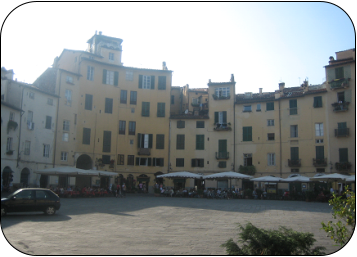 Internet searches in Ljubljana on http://www.knowitall.com had provided a list of B & Bs in the E 60 price range and a phone call to a non English speaking owner had raised hopes of maybe booking or perhaps not due to the vagaries of translation. The Lucca station is located just outside the old town providing an easy walk over the old moat, into the passageway through the walls and onto the pedestrian streets of inner Lucca. Walking the streets of known sectors popping into the piazza passing as Puccini’s hangout, leads to an enquiry at the concert door. An English speaking girl makes a call with suitable prompts to find out if our accommodation exists and if so the location.
Internet searches in Ljubljana on http://www.knowitall.com had provided a list of B & Bs in the E 60 price range and a phone call to a non English speaking owner had raised hopes of maybe booking or perhaps not due to the vagaries of translation. The Lucca station is located just outside the old town providing an easy walk over the old moat, into the passageway through the walls and onto the pedestrian streets of inner Lucca. Walking the streets of known sectors popping into the piazza passing as Puccini’s hangout, leads to an enquiry at the concert door. An English speaking girl makes a call with suitable prompts to find out if our accommodation exists and if so the location.
La Gemma Di Elena is at 363 via Della Zecca and the mythological Italian system of directions and street numbering comes into play as the desired destination is a bricked up doorway in ancient battlements. The last dialled number in the mobile phone elicits a fractured and contorted conversation which results in a head popping pronto out of a second floor window across the street.
Organised confusion reigns as to intentions, names, finally down to bookings with an enquiry of ‘quanta costa’ revealing a suite at E65 per night as the only option.
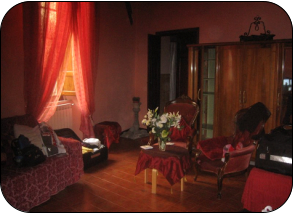 The scarlet brocaded boudoir would not have looked out of place in the Decameron of Boccaccio ,with chaise lounges, three lampshades ,king size fluffy bed, a single bed plus a four star, by Italian standards, ensuite. All guests use a lounge salon and anti room as a breakfast area and the large kitchen had a charm all of its own jam packed with food items, large modern oven and every kitsch accoutrement known to cuisine man. Breakfast runs the gamut of euro style fruit flan, toasted heavy bread, juices, jams, ham, salumi, cheeses, cereals and a bruising espresso doppio from a top quality machine.
The scarlet brocaded boudoir would not have looked out of place in the Decameron of Boccaccio ,with chaise lounges, three lampshades ,king size fluffy bed, a single bed plus a four star, by Italian standards, ensuite. All guests use a lounge salon and anti room as a breakfast area and the large kitchen had a charm all of its own jam packed with food items, large modern oven and every kitsch accoutrement known to cuisine man. Breakfast runs the gamut of euro style fruit flan, toasted heavy bread, juices, jams, ham, salumi, cheeses, cereals and a bruising espresso doppio from a top quality machine.
Via Della Zecca is typical of the Lucan street scape with most buildings around three to four floors high on narrow cobblestone streets that seem to totter about weirdly above the milling masses doing the daily business. The passage in daylight reveals that the best route to la Gemma di Elena is to travel along Via Fullungo beating a path down the premiere shopping street which does not deliver us from salvation only leads into temptation. Lucca is the place to visit when having a town sensation or alternate insular walled village retreat. People live in dwellings, go to work, commute, and have family gatherings in the piazzas in this car free town and the tourists flutter about the edge running bicycle interference. The home of Puccini is honoured with the best of the operatic hit parade played most nights at seven o’clock in churches in select piazzas. The Sunday session is the surrounding district flag throwing and trumpet competition an event harking back several centuries as the resounding boom of 75 drums brings all into Piazza Napoleon. This piazza epitomises what Lucca is about with large expanses of cobble space surrounded by large plain trees, presenting a relaxing demeanour surrounded by bustling cafes and trattorias.
An antique market rolls through many squares behind Napoleon and the bric a brac is tempting enough to think of ways to ship it back home to hell with the expense. A map is a necessity when charting the twisted streets and towering tenements so to find Tintoretto’s last Supper and the much touted representation of Christ by Nicodemus a circumlucca is approached with trepidation.
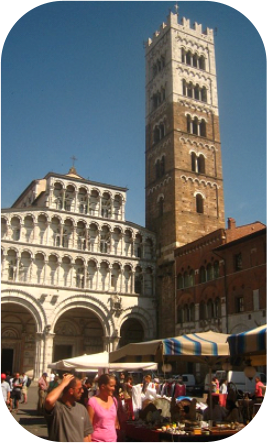 In the church of San Martino the carved Lebanese cedar statue of Jesus is purported to be ‘the only real depiction of the real Jesus’ as per Nicodemus the disciple, the face appearing at night via a few angels so we believe. The statue was not delivered from the holy land until later centuries when it miraculously was washed up on Italian shores to be driven to Lucca in an oxen cart without a driver. This appeared in 742, the provenance verified by the papacy or any unbiased Lucchesi and no doubt attributed to innumerable miracles.
In the church of San Martino the carved Lebanese cedar statue of Jesus is purported to be ‘the only real depiction of the real Jesus’ as per Nicodemus the disciple, the face appearing at night via a few angels so we believe. The statue was not delivered from the holy land until later centuries when it miraculously was washed up on Italian shores to be driven to Lucca in an oxen cart without a driver. This appeared in 742, the provenance verified by the papacy or any unbiased Lucchesi and no doubt attributed to innumerable miracles.
Perhaps its true value is its home in the Duomo di San Martino as it is surely a monumental edifice for it to repose. The church is one of the more interesting destinations and one could not help thinking of pagan undertones with the rich engraved tombs. For here in sculptured nooks those who could afford to pay to be buried here are supported with macabre attachments of skulls presenting a bat cave approach. The obligatory saving of body parts for any beatified being is part of the free entry to this imposingly high ceiling, a cool haven for an over churched, sceptical agnostic admiring the crucibles of fettered religion.
Lucca s prominence arose during the rule of the Irish monk Frediano, a bishop in the 5th century, as wealth came with the silk trade and a subsequent charter as an independent commune providing unbridled autonomy for 500 years. Once it was the second largest Italian city state second only to Venice, taken over by Napoleon Bonaparte and famously referred to in the opening sentence of Tolstoy’s War and Peace.
Lucca has a character of its own and to wander the large intact walls is a walking experience as the four sides have different tree species planted in each sector and people of all shapes and sizes cavort along the battlements. The main movement is via bicycle and an enlightening sight is smartly attired girls in high high heeled Gucci boots hopping unabashed onto bikes and slipping nonchalantly amongst the tourists in the pedestrian zones. Lucca comes alive after the pistiolo or siesta and it seems the bewitching hour as locals bring their cloistered exotica out to defecate. It is a D& G crowd with sparkles, white boots in named clothes as they cruise the alleys with the Ferraris of the canino world in poodle passigiata. These Pininfarina designer dogs are in direct competition and marginally higher in intellect than their owners as they spray and piddle down the glitter strips. Shopping with the panache that goes with Italian fashion is alive and well in the busy streets only requiring a black belt in serial purchasing to crucify the credit card. The nightly bustle is consumer heaven as the arcades and shop fitting presentation is highly competitive, bright and thrust into this scene is the clamour of café life to fill the gaps.
Wandering and perusing menus is the sedentary art of Italian life as an abundance of simple fresh menus ,without usurious copperto or extra charges ,seems an unfettered methodology suited to the towns persona. Beware the temptations to sit and order without due diligence in some establishments as what appears to be locals sitting contemplating may not translate to tourist charging in a two priced town. The only dining problem in Italy, still haunting change, is the propensity for outside dining to have serious smokers contemplating full, unemptied ashtrays and it is not uncommon to see chefs smoking at the front door prior and during service.
The casual attitude is brought home on the tables of number six San Frediano alimentary as the owners have a nonchalance almost bordering on arrogance. A menu crayoned on a table doyley is different each day with only six daily items at E6 to E7 a dish on tables covered in brown paper. Grab a seat if available hoping the guys may deign to clear the tables or perhaps they will just sit around and chew the fat before considering going about trade. The place was moving with pronto and buon sierra tossed verbally about, local’s espresso-ed or prosecco-ed in and out of the place, meals ebbed and flowed as staff skylarked in the casual atmosphere. Lunch became an antipasto and vino at E10 and the proprietors now started to take the mickey out of the beret wearing Australian that three times day a had become a living ,drinking vision of pati man. The itinerate traveller eats out and changes diet patterns at whim so the feeling of unhampered feeding or pressure tactics soon breeds familiarity and if the dining is tasty “comfy Food” say no more. The ultimate accolade is to perhaps be treated as one of ‘them’ and be allowed to serve oneself and enter the joshing repartee spoken at fifty decibels with prerequisite gesticulations as the Italian talking gymnastics takes place…..if only one could speak Italian.
The San Frediano church at the end of the piazza has the facade of the church decorated with a lavish thirteenth century mosaic and the interior is worth seeing as it houses a richly carved baptismal font as well as a shrine to Lucca’s saint, Santa Zita. So being Italy and its predilection to beatification and all things festive the mummified body is brought out once a year when she may be touched by the devout.
“Piazza Anfiteatro” or Piazza of the Amphitheatre, is built on the site of an original Roman amphitheatre, a ‘must-see’ in Lucca as the ancient site constitutes one of the most characteristic and original monuments of the city. The amphitheatre dates from the 2nd century A.D, built on an elliptical plan with two rows of 54 arcades and a maximum capacity of 10,000 spectators. Beginning in the middle Ages, houses were built over the ruins running juxtaposed and haphazardly into each other. During the course of time the piazza developed its characteristic oval and to wander around shops and trattorias with buildings all around it is like being a consumer gladiator wrestling with the beasts of time.
Prurient Pisa …. A day pass
Day tripping from Lucca to Pisa is only thirty minutes by train an efficient service squeezing through the nondescript suburb of Pisa Rossario and into the organised Pisa Centrale main station to search out the Information Office. Signage is clear and visible steering the traveller to info maps on a grid definitively laying out the city and major sites in the most simplistic tourist map imaginable. Follow the numbers and the signs head off down Via Francesco Crispi and the first ‘eyecon’ bobs up a treasure in the guise of Chiesa di Santa Maria della Spina on the footpath above the banks of the Arno.
This gothic, pert, white, highly ornate church wrestles with the traffic and could have been built in Hollywood were it not yet another significant Christian symbolic overkill. Yes folks this edifice was built to house a thorn taken from Christs Crown of Thorns and makes one wonder what relics could be possibly left over as the scavengers stripped the boys on the hill?
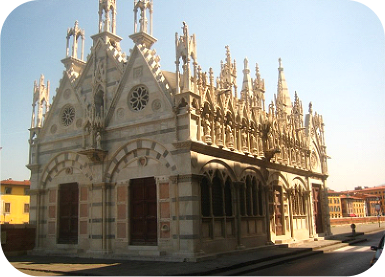 Onward Christian Soldiers for we are marching with the fanning masses to the field of miracles (Campo dei Miracoli) which begs the thought that it is a miracle you can see anything in the general crowd and clamour of getting to these “shrinking fields”.
Onward Christian Soldiers for we are marching with the fanning masses to the field of miracles (Campo dei Miracoli) which begs the thought that it is a miracle you can see anything in the general crowd and clamour of getting to these “shrinking fields”.
Leaning Tower, Duomo, Baptistry, Camposanto, green grass, grey tourists and everything leans including your wallet which falls over with trinket and souvenir rip-off. The Tower power is worth taking in along with every photographer doing trick shots of companions attempting to distort the view with angled arms outstretched propping the campanile or tower up. The area is swamped in tourist overkill and queues so it is a check of the icons tick the programme and pass into the streets searching for Piazza dei Cavalieri and a real horror story. The perimeter streets are less crowded but the main body is made up of students which no doubt accounts for the vast array of graffiti adorning buildings and walls in a tasteless fashion. Pisa has the world rights to political graffiti but this denigrates the worth of the countless courtyards and buildings along this journey as Latin enscriptions, busts, statues and an array of treasures indent these historical streets.
Cavalieri is built on the site of the Roman forum and now has the Scuola Normale Superiore one of Italy’s premiere universities with resplendent busts of the Grand old Dukes of Tuscany decorating the facades. At one end of the Piazza in keeping with the austerity of these gentlemen is the Palace of the Clocks (Palazzo dell’Orologio) with wrought iron baskets hanging off the walls where the heads of delinquent Pisans were placed. Perhaps they were sentenced for not pronouncing the name correctly of Ugolino della Gherardesca as this little piazza reveals horrors of another tale. I do not know what treachery this quaintly named gentleman performed as he was incarcerated in 1208 with his sons and grandsons and slowly starved to death. These murky parts of Pisano history were brought to the fore by Shelly in the “Tower of Famine” and Dante in his “Inferno” had gruesome innuendo pointing toward cannibalism.
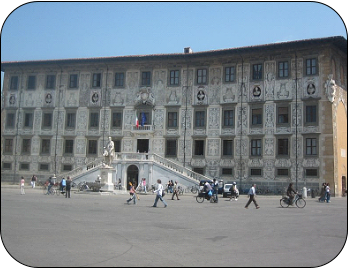 Time for the bistecca lunch from a salumerie which was conveniently weighed, a price quoted, wrapped in grease proof paper, twisted and rolled crisp and fresh. Next stop is a nearby enoteca for a great Tuscan sangiovese then adjourning to the courtyards of Dante Alighieri to eat amongst the students in the gardens. Slip past the San Michele in Borgo with its 14th century political Latin scribbling over the outer and into yet again another Piazza Garibaldi to slide into a recommended Olympic Gold Gelato prior to a wander along the banks of the Arno. La Bottega del Gelato was recommended for its whiskey cream and limoncello flavours and was inundated with creamers jostling to get served and sampling proved the pace was on for a medal.
Time for the bistecca lunch from a salumerie which was conveniently weighed, a price quoted, wrapped in grease proof paper, twisted and rolled crisp and fresh. Next stop is a nearby enoteca for a great Tuscan sangiovese then adjourning to the courtyards of Dante Alighieri to eat amongst the students in the gardens. Slip past the San Michele in Borgo with its 14th century political Latin scribbling over the outer and into yet again another Piazza Garibaldi to slide into a recommended Olympic Gold Gelato prior to a wander along the banks of the Arno. La Bottega del Gelato was recommended for its whiskey cream and limoncello flavours and was inundated with creamers jostling to get served and sampling proved the pace was on for a medal.
The short but fruitful journey through this place of tourist infamy is perhaps helped by brevity in expeditionary terms. The months of April to September are to busy for visiting Pisa as there is so much more to view in comparative relaxation it behoves to dream of what the winter season must be like.

